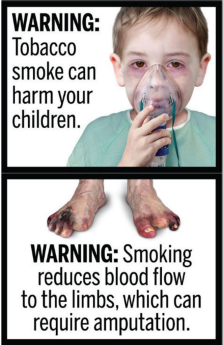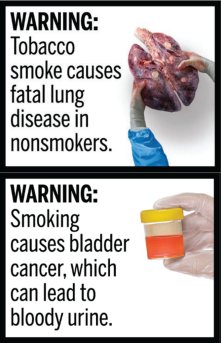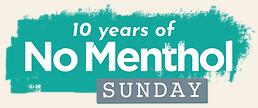|
Tobacco Control Program Newsletter |
|

After years of protracted tobacco industry litigation against the FDA, the U.S. Fifth District Court ruled that the FDA had the constitutional authority to require graphic photo-image warnings on cigarette packs sold in the U.S. At issue was whether mandated graphic warnings violated the First Amendment right of free speech. The court issued an opinion that graphic warnings did not violate free speech and they served a legitimate government interest of educating smokers about the health risks of smoking. Now public health advocates wait to see if tobacco companies appeal the court’s unanimous decision to a full Appellate Court or the Supreme Court.
|

The FDA Rule mandates that 50% of the back and front panels of cigarette packs be covered with rotating graphic warnings of 11 different types of diseases causally linked to smoking. The FDA adopted the final rule because evidence showed that consumers paid little attention to small text warnings and were unaware of the lesser-known smoking-related diseases such as bladder cancer and type 2 diabetes. In addition, FDA review of research in 20 countries that implemented graphic warnings showed that smokers exposed to warnings had increased knowledge of the health effects of smoking, had greater intention to quit, and consumed less cigarettes compared to smokers not exposed to warnings.
Mini warning ads on cigarette packs mimics the CDC TIPS media campaign on smoking and chronic disease and have the added advantage of directly linking graphic warnings to a smoker’s conditioned routine of reaching for a cigarette. A pack-a-day smoker would be exposed to a public health message on the dangers of smoking 7,000 times per year.
|
|
|
Meet Our TCP Partners: Lindsay Hauser, UVA Comprehensive Cancer Center
Lindsay is the Director for the UVA Cancer Center’s Office of Community Outreach and Engagement. In her role, she leads a team that provides high impact programming aimed at reducing cancer burden. This work includes providing services and programming focused on cancer screening and risk reduction, including tobacco. To learn more about the Office of Community Outreach and Engagement at UVA check out their website.
In her role, she also helps lead the Eliminate Tobacco Use Virginia Initiative, which aims to end tobacco use among college and university students, staff, and faculty. She helped lead the development of their tobacco policy surveillance system in 2021. This includes a detailed report card with a letter grade and score based on model tobacco policy. These report cards, which were recently updated in 2023, provide four-year public and private colleges and universities valuable information to guide their own policy work.
Lindsay resides in Charlottesville with her husband, two daughters, and Boston terrier, Finley. When not working, she enjoys taking advantage of her 4th grader’s National Park Pass and hiking all around Shenandoah National Park.
|
|
Cessation Highlight

It’s allergy season and tobacco use can worsen allergies and cause new allergic reactions. When someone smokes or inhales secondhand smoke, it irritates the airways, making allergy symptoms like sneezing, coughing, and wheezing worse. Tobacco smoke contains harmful chemicals that can trigger allergic reactions in some people, leading to itchy eyes, runny nose, and skin rashes. Moreover, smoking weakens the body's immune system, making it harder to fight off allergens. Children exposed to tobacco smoke are at a higher risk of developing allergies and asthma. Quitting smoking and avoiding secondhand smoke can help reduce allergy symptoms and improve overall health. It's essential to create smoke-free environments to protect ourselves and others from the harmful effects of tobacco on allergies. For help quitting, contact 1-800-Quit Now, Text ‘READY’ to 34191, or visit: QuitNowVirginia.org/.
|
|
|
Data Highlight
**These data are sourced from the Virginia Department of Health, Office of Vital Records, 2015-2022**
Whenever a death occurs in Virginia, a death certificate is issued. As part of that process, factors that may have contributed to the individual’s death are reported, including tobacco. Potential responses for the question “Did tobacco use contribute to death?” include Yes, No, Probably, and Unknown. The graph above represents the total percentage of deaths between 2015 and 2022 in Virginia where tobacco was reported as a contributing factor. Combining “Yes” and “Probably” (represented by the green bars in the graph) gives us a more complete view of the total percentage of people where tobacco likely played a role in their passing. Beginning in 2019, more than 1 in 10 people who died had tobacco listed as a contributing factor.
Encourage those you know who use tobacco or nicotine to visit our QuitNowVirginia.org website to learn more about the many resources in place to assist any individual on their quit journey!
|
|
Upcoming Events & Opportunities
The Cost of Access: Raising the Price of Tobacco Products - Tobacco products are often the cheapest in neighborhoods with the lowest income levels which helps perpetuate the tobacco industry’s hold in targeted communities. Learn how states and local governments can counter the tobacco industry's reduced prices. Register for this webinar on April 10th at 2 PM hosted by the Public Health Law Center here.
Drug-Free Communities (DFC) Program Funding Announcement - Youth substance use remains a leading public health concern. The (DFC) Program provides community coalitions with grant funding and an extensive, national support system to mobilize local youth substance use prevention efforts. There are two notices of funding opportunities (NOFO) available on www.grants.gov for community-based coalitions that have never received DFC funding before and for those who have. Applications are due on April 17th.

May 19: Menthol Sunday - This is the TENTH year of No Menthol Sunday, an event held on the third Sunday of May that helps spread awareness about how tobacco and flavors like menthol are impacting the Black community. For more information and free resources visit their website, here.
|
|
|
Tobacco Control in the News

FamHealth project, a collaboration among the University of Virginia Cancer Center, UVA Wise, Coeburn Middle School, and Virginia Cooperative Extension, has been tackling the generational cycle of tobacco use through student-developed educational interventions with the help of college-aged peer mentors. Supported by a VFHY Community Innovation grant, the initiative aimed to equip students with knowledge and skills while empowering them to craft impactful anti-tobacco messages for parents and the wider community.
To showcase the project and the powerful messaging driven by students, the team has compiled a VFHY FamHealth one-pager. This document showcases project achievements, student insights, Quit Now Virginia contact information, and tobacco prevention conversation starters. For questions about the FamHealth project, please contact Brenna Robinson at br5me@uvahealth.org.
|
Sociodemographic and Temporal Differences in Menthol Cigarette Use Among U.S. Adults Who Smoke, 1999–2018 - This study examined sociodemographic and temporal differences in menthol cigarette use among U.S. adults aged 20 years or older who smoke. Non-Hispanic Black adults who smoke had the highest prevalence of menthol cigarette use among all racial and ethnic groups. The prevalence of menthol cigarette use among adults who smoke increased, especially among Mexican American adults, younger adults, and adults who reported fair to poor health status. Read more here.
Comprehensive vaping bans are associated with lower odds of initiation into electronic nicotine delivery systems use among young people - Among youth, residing in a state with a comprehensive vaping ban was associated with 18% lower odds of ENDS initiation. Read more here.
Please share with your partners!
|
|
|
Free help to quit tobacco.
Quit Coaches available for support.
|
|
Online education for adults.
A texting program for youth.
|
|
- Becoming a Tobacco Free Worksite,
- Referring your patients and clients proactively to Quit Now Virginia,
- Finding your local tobacco and nicotine coalition, or
- Scheduling a tobacco and nicotine related training for your staff or community.
|
|
|
|
|